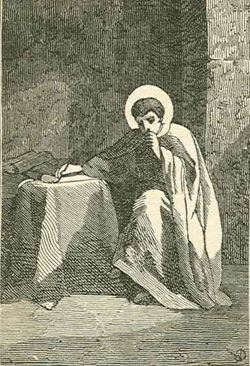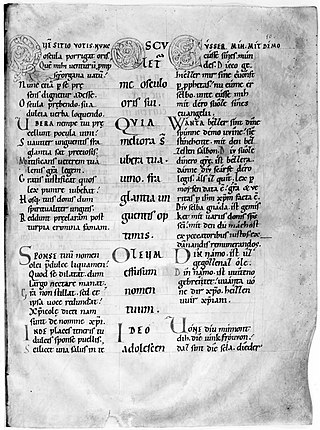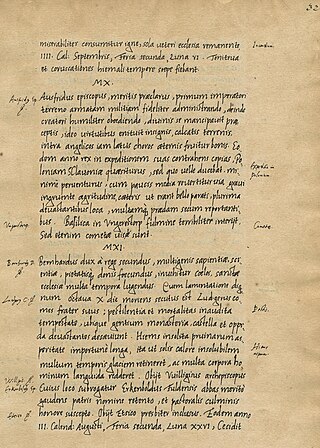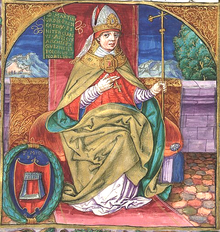
The Liber Pontificalis is a book of biographies of popes from Saint Peter until the 15th century. The original publication of the Liber Pontificalis stopped with Pope Adrian II (867–872) or Pope Stephen V (885–891), but it was later supplemented in a different style until Pope Eugene IV (1431–1447) and then Pope Pius II (1458–1464). Although quoted virtually uncritically from the 8th to 18th centuries, the Liber Pontificalis has undergone intense modern scholarly scrutiny. The work of the French priest Louis Duchesne, and of others has highlighted some of the underlying redactional motivations of different sections, though such interests are so disparate and varied as to render improbable one popularizer's claim that it is an "unofficial instrument of pontifical propaganda."

Pope Joan was, according to legend, a woman who reigned as pope for two years during the Middle Ages. Her story first appeared in chronicles in the 13th century and subsequently spread throughout Europe. The story was widely believed for centuries, but most modern scholars regard it as fictional.
Pope Gelasius I was the bishop of Rome from 1 March 492 to his death on 19 November 496. Gelasius was a prolific author whose style placed him on the cusp between Late Antiquity and the Early Middle Ages. Some scholars have argued that his predecessor Felix III may have employed him to draft papal documents, although this is not certain.
Pope Damasus II was the Bishop of Rome and ruler of the Papal States from 17 July 1048 to his death on 9 August that same year. He was the second of the German pontiffs nominated by Emperor Henry III. A native of Bavaria, he was the third German to become pope and had one of the shortest papal reigns.

Regino of Prüm or of Prum was a Benedictine monk, who served as abbot of Prüm (892–99) and later of Saint Martin's at Trier, and chronicler, whose Chronicon is an important source for late Carolingian history.
Dietrich of Nieheim, medieval historian, was born at Nieheim, a small town subject to the see of Paderborn.

Prosper of Aquitaine, also called Prosper Tiro, was a Christian writer and disciple of Augustine of Hippo, and the first continuator of Jerome's Universal Chronicle.

Jans der Enikel, or Jans der Jansen Enikel, was a Viennese chronicler and narrative poet of the late 13th century. He wrote a Weltchronik and a Fürstenbuch, both in Middle High German verse.

Czech Silesia is the part of the historical region of Silesia now in the Czech Republic. Czech Silesia is, together with Bohemia and Moravia, one of the three historical Czech lands.
Lambert of Hersfeld was a medieval chronicler. His work represents a major source for the history of the German kingdom of Henry IV and the incipient Investiture Controversy in the eleventh century.

The Kaiserchronik is a 12th-century chronicle written in 17,283 lines of Middle High German verse. It runs from Julius Caesar to Conrad III, and seeks to give a complete account of the history of Roman and German emperors and kings, based on a historiographical view of the continuity of the Roman and German successions. The overall pattern is of a progression from pagan to Christian worlds, and theological disputations stand at the turning-points of the Christianization of the Empire. However, much of the material is legendary and fantastic, suggesting that large sections are compiled from earlier works, mostly shorter biographies and saints' lives.

Williram of Ebersberg was a Benedictine Abbot. He is best known for his 'Expositio in Cantica Canticorum', a complex commentary of the Song of Songs which includes an Old High German translation and a Latin verse paraphrase.

The Gesta principum Polonorum is the oldest known medieval chronicle documenting the history of Poland from the legendary times until 1113. Written in Latin by an anonymous author, it was most likely completed between 1112 and 1118, and its extant text is present in three manuscripts with two distinct traditions. Its anonymous author is traditionally called Gallus, a foreigner and outcast from an unknown country, who travelled to the Kingdom of Poland via Hungary. Gesta was commissioned by Poland's then ruler, Boleslaus III Wrymouth; Gallus expected a prize for his work, which he most likely received and of which he lived the rest of his life.
Bonizo of Sutri or Bonitho was a Bishop of Sutri and then of Piacenza in central Italy, in the last quarter of the 11th century. He was an adherent of Gregory VII and an advocate of the reforming principles of that pope. He wrote three works of polemical history, including Liber ad amicum, which detailed the struggles between civil and religious authorities. He was driven out of both of his dioceses, once by the emperor and once by opponents of Gregorian-style reform.
Richard of Poitiers, also known as Richard of Cluny, was a monk of the Benedictine abbey of Cluny, and author of a small number of historical works, treatises and poems.
Bernhard Bischoff was a German historian, paleographer, and philologist; he was born in Altendorf, and he died in Munich.
Anonymus Leobiensis or Chronicon Leobiense is the conventional name for a Latin chronicle written in or shortly after 1345. It covers the years from the incarnation of Christ down to 1345 with an emphasis on the Holy Roman Empire and the Papacy. The author was certainly a cleric and a native of Leoben in the Duchy of Styria. He has been tentatively identified with Conrad of Leoben, a lecturer at the Dominican church in Vienna.
Peter Herde is a German historian. His research activities range from fundamental work on papal diplomatics of the Middle Ages to the history of the country up to the Second World War.

The Liber Nycholay is a Latin biography of Muhammad. It is an anonymous text, written in Italy in the later 13th century. Of no value as a historical source on Muhammad, it is a melding of various western Christian traditions concerning the origins of Islam written in such a way as to highlight the similarities between Islam and Catholic Christianity while satirizing the papal court.

Liudger, also Liutger, Ludiger, Liudiger or Luderus, Low German Lüder, was the younger brother of the Saxon Duke Bernhard I of the Billung dynasty. In the historical sources Liudger is called Graf (count). There he appears almost only at the side of his older brother.












